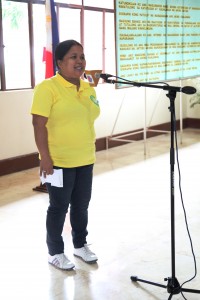
A once-bereaved mother said that becoming a volunteer for a project of the Department of Social Welfare and Development (DSWD) has helped her forget the pain of losing two of her four children.
Charina David from Paliparan III, Dasmarinas, Cavite, lost a child who had cerebral palsy. And soon after, another child died driving the grief-stricken mother to gambling.
“Natuto po akong magsugal para lamang makalimutan ang sakit na dala ng pagkamatay ng aking dalawang anak (I learned to gamble to temporarily forget the pain of losing my two children),” Charina narrated before officials and employees of the
DSWD, where she was invited to share how she gained renewed strength from the Kapit-Bisig Laban sa Kahirapan-Comprehensive and Integrated Delivery of Social Services (Kalahi-CIDSS) Japan Social Development Fund-Livelihood for Vulnerable Urban Communities (JSDF-LVUC).
JSDF-LVUC is implemented in urban areas to provide livelihood support for communities affected by poverty.
Using the community-driven development (CDD) strategy of Kalahi-CIDSS, residents identify what livelihood interventions they need. In the case of Dasmariñas, interested residents were provided trainings in refrigeration and air conditioning (RAC) servicing, dressmaking, and consumer electronics.
At the same time, they also got infrastructure projects, specifically the improvement of a 285.15 km concrete line canal with a provision of 1,265.34 linear meter canal cover, and declogging of 29,743.2 linear meter line canal.
According to Charina, being involved in the Kalahi-CIDSS as Chairperson of the Community Sub-Project Management Implementation Committee (CSPMIC) positively changed her life.
“Dahil sa pagiging abala ko bilang volunteer sa KALAHI-CIDSS, naging malakas ang aking loob, nakalimutan ko ang aking pinagdadaan, at nagkaroon ako ng tiwala sa aking sarili (Because of KALAHI-CIDSS, I became empowered, I overcome my depression, and gained self-confidence),” Charina enthused.
“Bilang isang Community Volunteer ng JSDF-LVUC Project, nagkaroon ako ng kaalaman tungkol sa aming barangay, katulad ng pagsusuri kung ano ang aming kalagayan, pati na ang mga suliranin kung kaya’t ito ay nagkaroon ng solusyon sa pamamagitan ng proyekto (As a community volunteer of JSDF-LVUC Project, I gained knowledge about the situation in our barangay, such as analyzing our problems and coming up with solutions through the project),” Charina shared.
“Sa pag-implement ng project ay nakasalamuha ko ang iba’t ibang tao, kabilang po rito ang mga local na opisyal ng aming LGU (In implementing the project, I mingled with all kinds of people, including our local officials),” she continued.
Being productive
Charina also emphasized that because of Kalahi-CIDSS, she became productive.
Aside from being the CSPMIC Chairperson on Infrastructure, she was also one of the beneficiaries of a skills training program, graduating from the dressmaking course of the Technical Education and Skills Development Authority (TESDA).
“Natutunan naming mahalaga po palang makilahok tayo upang magkaroon ng kaalaman sa ating pamayanan. Salamat sa Kalahi-CIDSS, naging maayos at maganda ang aming buhay (We learned that it is important to be involved so we would know what is going on in our community. Thanks to Kalahi-CIDSS, our lives became better),” she concluded.
“Kaya pala nating lampasan ang lahat ng ating pinagdaraanan basta mayroon tayong makabuluhang gawain sa halip na magbisyo (We can rise above our depression as long as we focus our attention on worthwhile endeavors rather than to drown ourselves into vices),” Charina said.
Urban CDD
Originally exclusively covering rural areas, Kalahi-CIDSS began its urban CDD pilot through JSDF-LVUC in 2011 in Barangay Ligtong III in Rosario, Cavite and in three communities in Malate, Manila.
As of September 15, Kalahi-CIDSS JSDF-LVUC was able to implement 46 sub-projects, of which 17 are infrastructure sub-projects and 29 are vocational technical skills training sub-projects, benefiting 4,494 individuals from nine barangays in four municipalities in Cavite, five barangays in two municipalities in Laguna, and three barangays in Malate, Manila.
Ten barangays in Malabon and six in Muntinlupa are also undergoing pre-implementation activities for the program. ###


